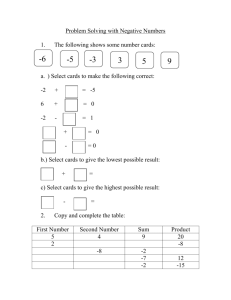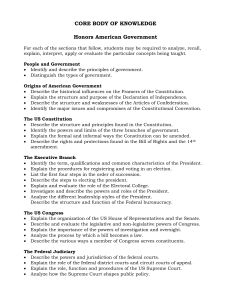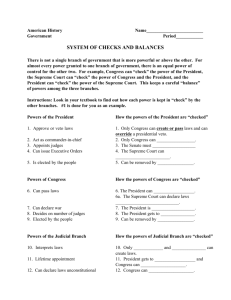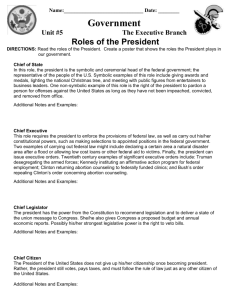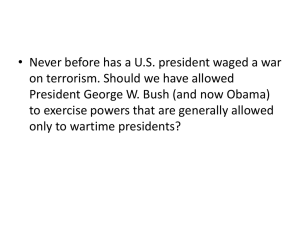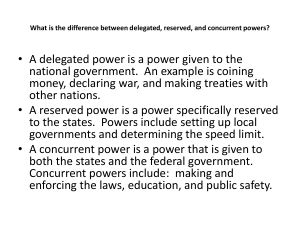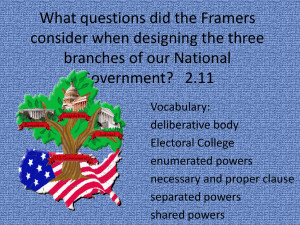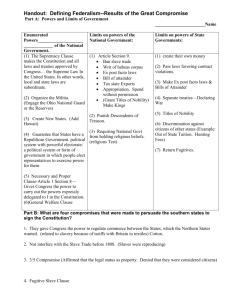12DL War Powers Act and the Constitution
advertisement
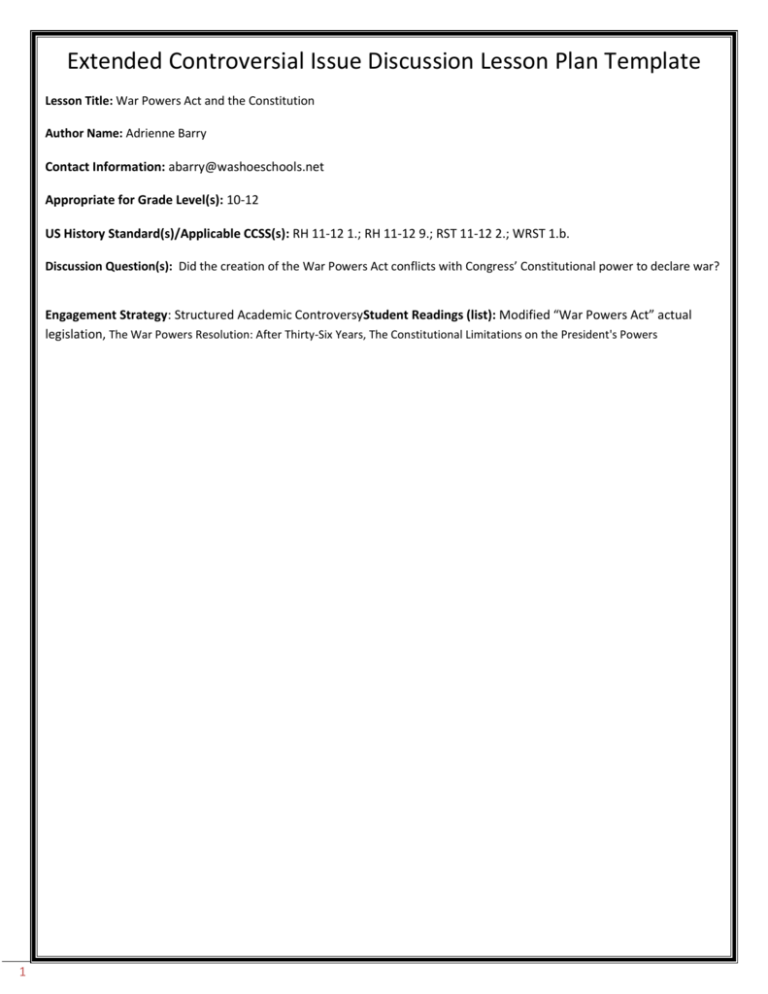
Extended Controversial Issue Discussion Lesson Plan Template Lesson Title: War Powers Act and the Constitution Author Name: Adrienne Barry Contact Information: abarry@washoeschools.net Appropriate for Grade Level(s): 10-12 US History Standard(s)/Applicable CCSS(s): RH 11-12 1.; RH 11-12 9.; RST 11-12 2.; WRST 1.b. Discussion Question(s): Did the creation of the War Powers Act conflicts with Congress’ Constitutional power to declare war? Engagement Strategy: Structured Academic ControversyStudent Readings (list): Modified “War Powers Act” actual legislation, The War Powers Resolution: After Thirty-Six Years, The Constitutional Limitations on the President's Powers 1 Total Time Needed: [Type text] Lesson Outline: 1.5 70 minute blocks Time Frame What is the teacher doing? What are students doing? (e.g. 15 minutes) 10 Mins Homework 5 5 5 Description of procedures/ norms 10 5 Overseeing productive discussion Facilitating writing prompt Assigning groups/ points of view Walking around 10 5 10 Facilitates whole group discussion 5 Essay Assignment Listening Reading/ taking notes on key points Students summarize information from readings Moving to groups Students are discussing their discussion points with their partner Side A is presenting their points/ B is taking notes Side B presents questions and summarizes Side A points Side B presents points/ Side A takes notes Side A presents questions and summarizes Side B points Side A students present their major points, Side B present their major points Description of Lesson Assessment: Students will write an essay addressing the over-arching question of the discussion. How will students reflect on the process and their learning? On accompanying work sheets/ essay assignment. The pages that follow the Lesson Plan Template include a detailed background paper on the topic for teachers, student readings and reading strategy/questions, source(s), handouts, assignment sheet, self-assessment/reflection and a rubric related to this lesson. Does the War Powers Resolution of 1973 challenge Congress’ power to declare war? The War Powers Act states, “The President in every possible instance shall consult with Congress before introducing United States Armed Forces into hostilities or into situation where imminent involvement in hostilities is clearly indicated by the circumstances, and after every such introduction shall consult regularly with the Congress until United States Armed Forces are no longer engaged in hostilities or have been removed from such situations.”1 The intent of the War Powers Act, which will be henceforth referred to as “WPA 1973”, was to limit the power of the president in reference to engagement in military intervention. Created in an era that resulted in death as well as division within the nation, the WPA 1973 was and continues to be a highly controversial piece of legislation within the United States. Although the War Powers Act was initially created in 1941 as an instrument for America to engage in World War II, the War Powers Act was changed greatly in the midst of the Vietnam conflict. Due to the highly controversial nature of the Vietnam conflict, Congress believed the powers of the Executive needed to be checked. Since the president is cited as the Commander in Chief in the United States Constitution, some debate surrounds WPA 1973. Some believe that the President should be allowed to make military decisions within the jurisdiction of his fulfillment of the role of Commander in Chief. Others believe that without the consent of Congress to declare war, which is also required by the constitution, the power of the executive is much greater, thus challenging the balance of powers among the branches. Both perspectives will be further explored and explained throughout the paper. Although the Constitution reserves the President of the United States as the Commander in Chief of our armed forces, the Constitution gave the power to actually declare war to Congress. Congress exhibited great concern regarding the President having the power to engage in military conflicts without their consent, “The congressional view was that the framers of the Constitution gave Congress the power to declare war, meaning the ultimate decision whether or not to enter a war.”2 The framers believed it was important to maintain a balance of powers between the legislative and the executive regarding the power to declare war. The Tonkin Gulf Resolution challenged this balance as the president felt it was necessary to engage in military action as a result of an attack in the Tonkin Gulf. The Tonkin Gulf Resolution was seen by many as a way to circumvent to necessary checks set out by the constitution. “Penetrating beneath the skin, 1 2 The War Powers Act 1973, H . Res. 542, 93rd Congress, November 7, 1973 S. 3. Grimmett, Richard F. The War Powers Resolution: After Thirty-Six Years. Congressional Research Service. April 22, 2010. Page 11. The pages that follow the Lesson Plan Template include a detailed background paper on the topic for teachers, student readings and reading strategy/questions, source(s), handouts, assignment sheet, self-assessment/reflection and a rubric related to this lesson. however, reveals true intent, and in the case of the Tonkin Gulf Resolution it is clear that Congress intended only that military action be used to repel an allegedly ‘unprovoked attack’ by a few gun boats. It was certainly no carte blanche to the Executive to wage large scale war unilaterally and indefinitely.”3 In addition to the Tonkin Gulf Resolution, the WPA 1973 was created to assist in more clearly defining the role of the president regarding engagements abroad. The WPA 1973 stated that, “The constitutional powers of the President as Commander-in-Chief to introduce United States Armed Forces into [actual or imminent hostilities]… are exercised only pursuant to (1) a declaration of war, (2) specific statutory authorization, or (3) a national emergency created by attack on the United States, its territories or possessions, or its armed forces.”4 Although the idea was to more clearly define the role of the Executive, WPA 1973 created a loophole in which many Presidents will exploit. This loophole is based within the language, a national emergency or imminent threat. These are the ideas that have allowed the Executive to become engaged abroad more easily than ever before. While the Congress interpreted its use of the Tonkin Gulf Resolution and the War Powers Act in one way, the Executive chose to interpret in another way. There are a few ambiguities that allow the Executive to exploit the guidelines set about in WPA 1973. One example of an ambiguity is, “The WPR neither defines ‘consult’ nor indicates whom the President is to consult, so presidents have often purported to ‘consult with Congress’ by simply notifying a few selected members, sometimes only hours before forces engaged in hostilities.” This oversight directly conflicts with the purpose of the document. If there are loopholes in which the President may abuse, the resolution is null. This truly raises the constitutionality of the resolution in its entirety. Does this challenge the basic idea of Congress determining whether or not to engage in war? The executives have utilized the War Powers Resolution countless times since its enactment to engage in military conflict without an official declaration of war. One example was after the attacks on the World Trade Center buildings on September 11, 2001. “President George W. Bush reported to Congress, ‘consistent with the War Powers Resolution,’ and ‘Senate Joint Resolution 23’ that on October 7, 2001, U.S. Armed Forces ‘began combat action in Afghanistan against Al Qaida terrorists and their Taliban supporters.’”5 Bush used the nuances in the 3 4 5 Goldberg, Arthur "The Constitutional Limitations on the President's Powers," The American University Law review, 22, no. 4 (1973): 680-681. Ibid. Grimmett, Richard F. The War Powers Resolution: After Thirty-Six Years. Congressional Research Service. April 22, 2010. Page 45. The pages that follow the Lesson Plan Template include a detailed background paper on the topic for teachers, student readings and reading strategy/questions, source(s), handouts, assignment sheet, self-assessment/reflection and a rubric related to this lesson. resolution to get involved abroad without the consent of Congress. It basically allowed Bush to inform Congress that military action had been initiated, rather than ask Congress for its consent for initiated. The WPA 1973 has created much confusion regarding the jurisdiction of military action, “deployments without congressional authorization have sometimes been defended on the grounds that the WPR authorizes the President to use forces in hostilities for sixty days and does not require their withdrawal before that time (absent a two-house veto that is probably unconstitutional).”6 The War Powers Act of 1973 has been greatly debated since its establishment. While it was initially created in order to limit the Executive’s power, it may have actually expanded presidential powers. The Congress strongly believes that it is absolutely necessary to follow the desires of the founding fathers in regards to balancing the Commander in Chief’s role and the Legislative Branch. The executive believes it should have an ability to engage in conflicts regardless of congressional consent if it sees necessary. Nuances in the language used in the War Powers Resolution have in some ways pleased both parties, but created confusion as well. Does the War Powers Resolution of 1973 challenge the constitution in regards to Congress’ power to declare war? 6 Ibid The pages that follow the Lesson Plan Template include a detailed background paper on the topic for teachers, student readings and reading strategy/questions, source(s), handouts, assignment sheet, self-assessment/reflection and a rubric related to this lesson. Question: The creation of the War Powers Act conflicts with Congress’ Constitutional power to declare war. 1 2 3 4 5 6 7 8 9 10 11 12 13 14 15 16 17 18 19 20 21 22 23 24 25 26 27 28 DOCUMENT 1 The Congress’s Constitutional Role in War Powers The framers shared the view that an absolute monarch would be prone to squandering7 his subjects’ lives and money on reckless military adventures. “Absolute monarchs,” John Jay wrote in The Federalist Papers, “will often make war when their nations are to get nothing by it, but for purposes and objects merely personal, such as thirst for military glory, revenge for personal affronts8, ambition, or private compacts to aggrandize9 or support their particular families or partisans.” The best precaution against unilateral10 war-making by the executive was to require a collective decision to go to war. “It will not be in the power of a single man, or a single body of men, to involve us in such distress; for the important power of declaring war is vested in the legislature at large,” James Wilson later explained to the Pennsylvania ratifying convention. Moreover, vesting this power in the whole Congress meant that the popularly-elected House, the body most directly responsive to the voters, had to act and so helped to assure the widest possible political consensus for war. The Senate — originally chosen by state legislatures — could not alone provide this assurance. Since the people could not be asked directly whether the nation should go to war, requiring the assent of the House as well as the Senate was the next best thing. If presidents bent on war could not persuade the Congress, they presumably could not persuade the people either and would therefore lack the consensus required to assume the costs and risks of war. In short, the framers insisted on a collective judgment for war because it was likely that a collective judgment would be superior to an individual judgment, would help assure that the United States would not go to war without a political consensus11, and, by requiring a President to persuade Congress, would effectively make him or her explain why war was necessary to the public who would ultimately bear its cost. These reasons for insisting on a collective judgment for war are still valid today. For the foregoing reasons, the Constitution assigns to the full Congress the power “[t]o declare War [and] grant Letters of Marque and Reprisal.” According to international law in 1789, a state could declare war either by “word or action,” as the influential political theorist John Locke put it. A state publicly announced the state of war “by word” by making a formal declaration of war and delivering it to the enemy. A state initiated a state of war “by action” simply by committing an act of war. 7 to spend or use extravagantly or wastefully a personally offensive act or word 9 increase in size or intensity 10 relating to, occurring on, or involving one side only 11 majority of opinion 8 The pages that follow the Lesson Plan Template include a detailed background paper on the topic for teachers, student readings and reading strategy/questions, source(s), handouts, assignment sheet, self-assessment/reflection and a rubric related to this lesson. Question: The creation of the War Powers Act conflicts with Congress’ Constitutional power to declare war. 1 2 3 4 5 6 7 8 9 10 11 12 13 14 15 16 17 18 19 20 21 22 23 24 25 26 27 28 29 30 31 32 DOCUMENT 2 THE CONSTITUTIONAL LIMITATIONS ON THE PRESIDENT'S POWERS The expansion of presidential power in the conduct of foreign relations threatens to destroy our system of separation of powers in the war power area.' Relying on notions of the scope of their power as Commander in Chief, recent Presidents have unilaterally determined whether this nation should engage in prolonged hostilities 12 abroad. In doing so, the Executive has pursued a hegemonous course into the war power domain of Congress 13 which has led to the usurpation of Congress' war declaring role. The arguments that allegedly support a broad14 based presidential prerogative to wage war in the absence of a congressional declaration of war, have been rebutted by other commentators. Yet, while the war power issue can be resolved on academic grounds by reference to one document-the Constitution-the prevention of future unauthorized uses of the war power by the President will only come about when Congress forcibly reasserts itself by legislating in this vital area. The proposed War Powers Act' discussed later in this section represents the best effort to date by the Senate to restore our constitutional scheme. "Nothing in the Constitution is plainer," Justice Jackson observed in the Steel Seizure Case, 15 "than that declaration of a war is entrusted only to Congress." Indeed the Constitution is unambiguous and 16 unequivocal in conferring this most important facet of the war power on the Legislature: "Congress shall have power . . . to declare war."' One does not have to be a jurist or a lawyer to understand these explicit words; nor does one have to be an historian, although the constitutional debates are clear that Congress was entrusted with the power to sanction the use of the sword. In fact, the question of the meaning of the war-making power vis-a17 vis the President, which has caused so much consternation in recent years, was confronted, debated, and answered by the delegates to the Philadelphia convention in August 1787. In agreeing to give Congress the power "to declare war" as opposed "to make war," the delegates made it clear that the President was given only a limited mandate to repel sudden attacks against the United States The President's repelling power is by definition a defensive exercise of force and was conferred solely to provide the President with the power to respond to a surprise attack or to forestall an invasion against this nation until Congress could act. It was by no means a mandate to Presidents to initiate hostilities abroad in the absence of a congressional declaration of war… The constitutional role of Congress, therefore, is not merely to legislate war into existence. It extends far beyond that, permitting Congress to legislate regarding the scope of hostilities to be engaged in and the general course and conduct of war to be pursued… Penetrating beneath the skin, however, reveals true intent, and in the case of the Tonkin Gulf Resolution it is clear that Congress intended only that military action be used to repel an allegedly "unprovoked attack" by a few gun boats. It was certainly no carte blanche to the Executive to wage large scale war unilaterally and indefinitely. 12 leadership; predominance. illegal seizure and occupation of a throne. 14 an exclusive right, privilege, etc., exercised by virtue of rank, office, or the like 15 not ambiguous; clear 16 absolute; unqualified; clear 17 in relation to; compared with 13 The pages that follow the Lesson Plan Template include a detailed background paper on the topic for teachers, student readings and reading strategy/questions, source(s), handouts, assignment sheet, self-assessment/reflection and a rubric related to this lesson. Question: The creation of the War Powers Act conflicts with Congress’ Constitutional power to declare war. 1 2 3 4 5 6 7 8 9 10 11 12 13 14 15 16 17 18 19 20 21 22 23 24 25 26 27 28 DOCUMENT 3 War Powers of President and Congress The heart of the challenge to the constitutionality of the War Powers Resolution rests on differing interpretations by the two branches of the respective war powers of the President and Congress. These differing interpretations, especially the assertions of presidential authority to send forces into hostile situations without a declaration of war or other authorization by Congress, were the reason for the enactment of the Resolution. The congressional view was that the framers of the Constitution gave Congress the power to declare war, meaning the ultimate decision whether or not to enter a war. Most Members of Congress agreed that the President as Commander-in-Chief had power to lead the U.S. forces once the decision to wage war had been made, to defend the nation against an attack and perhaps in some instances to take other action such as rescuing American citizens. But, in this view, he did not have the power to commit armed forces to war. By the early 1970s, the congressional majority view was that the constitutional balance of war powers had swung too far toward the President and needed to be corrected. Opponents argued that Congress always held the power to forbid or terminate U.S. military action by statute or refusal of appropriations, and that without the clear will to act the War Powers Resolution would be ineffective. In his veto message, President Nixon said the Resolution would impose restrictions upon the authority of the President which would be dangerous to the safety of the Nation and “attempt to take away, by a mere legislative act, authorities which the President has properly exercised under the Constitution for almost 200 years.” The War Powers Resolution in section 2(c) recognized the constitutional powers of the President as Commander-in-Chief to introduce forces into hostilities or imminent hostilities as “exercised only pursuant to (1) a declaration of war, (2) specific statutory authorization, or (3) a national emergency created by attack upon the United States, its territories or possessions, or its armed forces.” The executive branch has contended that the President has much broader authority to use forces, including for such purposes as to rescue American citizens abroad, rescue foreign nationals where such action facilitates the rescue of U.S. citizens, protect U.S. Embassies and legations18, suppress civil insurrection19, implement the terms of an armistice or cease-fire involving the United States, and carry out the terms of security commitments contained in treaties. 18 19 a diplomatic minister and staff in a foreign mission. an act or instance of rising in revolt The pages that follow the Lesson Plan Template include a detailed background paper on the topic for teachers, student readings and reading strategy/questions, source(s), handouts, assignment sheet, self-assessment/reflection and a rubric related to this lesson. Question: The creation of the War Powers Act conflicts with Congress’ Constitutional power to declare war. 1 DOCUMENT 4 2 The War Powers Act of 1973 3 50 USC S.1541-1548, 1973 4 5 6 7 The War Powers Resolution, generally known as the War Powers Act, was passed by Congress over President Nixon's veto to increase congressional control over the executive branch in foreign policy matters, specifically in regard to military actions short of formally declared war. Its central provision prohibited the President from engaging in military actions for more than sixty days, unless Congress voted approval. 8 The key Section 1541(c) reads: 9 10 11 12 13 (c) Presidential Executive Power as Commander-in-Chief; Limitation The constitutional powers of the President as Commander-in-Chief to introduce United States Armed Forces into hostilities, or into situations where imminent involvement in hostilities is clearly indicated by the circumstances, are exercised only pursuant to (1) a declaration 20 of war, (2) specific statutory authorization, or (3) a national emergency created by attack upon the United States, its territories or possessions, or its armed forces… 14 Purpose and Policy 15 16 17 18 19 Sec. 2. (a) It is the purpose of this joint resolution to fulfill the intent of the framers of the Constitution of the United States and insure that the collective judgment of both the Congress and the President will apply to the 21 introduction of United States Armed Forces into hostilities, or into situations where imminent involvement in hostilities is clearly indicated by the circumstances, and to the continued use of such forces in hostilities or in such situations. 20 21 22 23 (b) Under article I, section 8, of the Constitution, it is specifically provided that the Congress shall have the power to make all laws necessary and proper for carrying into execution, not only its own powers but also all other powers vested by the Constitution in the Government of the United States, or in any department or officer thereof. 24 25 26 27 (c) The constitutional powers of the President as Commander-in-Chief to introduce United States Armed Forces into hostilities, or into situations where imminent involvement in hostilities is clearly indicated by the circumstances, are exercised only pursuant to (1) a declaration of war , (2) specific statutory authorization, or (3) a national emergency created by attack upon the United States, its territories or possessions, or its armed forces… 28 20 21 Pertaining to a specific law likely to occur at any moment; impending The pages that follow the Lesson Plan Template include a detailed background paper on the topic for teachers, student readings and reading strategy/questions, source(s), handouts, assignment sheet, self-assessment/reflection and a rubric related to this lesson. Question: The creation of the War Powers Act conflicts with Congress’ Constitutional power to declare war. 1 DOCUMENT 5 2 2. Consulting and Reporting Under the WPR (War Powers Resolution) 3 4 5 6 7 8 9 10 11 12 The WPR requires a President “in every possible instance…[to] consult with Congress” before, and to report to it within forty-eight hours after, deploying U.S. armed forces into actual or imminent hostilities, foreign territory, airspace, or waters, or in numbers which “substantially enlarge” combat-equipped U.S. forces already located in a foreign nation. All reports must set forth the circumstances necessitating the introduction of forces, the authority for the introduction, and the “estimated scope and duration of the hostilities or involvement,” but only a report of a deployment into actual or imminent hostilities (a “hostilities report”) starts the sixty-day clock running. Although President Nixon conceded that the consulting and reporting requirements were “constructive measures…[which] would foster [inter-branch cooperation in exercising war powers]…by enhancing the flow of information from the 22 executive branch to the Congress,” presidents have consistently exploited ambiguities in these requirements to render them effectively meaningless. 13 14 15 16 17 18 19 The WPR neither defines “consult” nor indicates whom the President is to consult, so presidents have often purported to “consult with Congress” by simply notifying a few selected members, sometimes only hours before forces engaged in hostilities. Because only “hostilities reports” start the sixty-day clock, all presidents after President Ford have submitted reports that are strategically silent about the subsection under which they are submitted. Moreover, even when these reports have described the circumstances, their identification of the authority for the deployment and their assessment of the scope and duration of hostilities are usually perfunctory boilerplate. Periodic follow-up reports required by the WPR have rarely filled in the details. 22 doubtfulness or uncertainty of meaning or intention The pages that follow the Lesson Plan Template include a detailed background paper on the topic for teachers, student readings and reading strategy/questions, source(s), handouts, assignment sheet, self-assessment/reflection and a rubric related to this lesson. Question: The creation of the War Powers Act conflicts with Congress’ Constitutional power to declare war. Works Cited 1. 2. 3. 4. 5. The War Powers Act 1973, H . Res. 542, 93rd Congress, November 7, 1973 S. 3. Grimmett, Richard F. The War Powers Resolution: After Thirty-Six Years. Congressional Research Service. April 22, 2010. Goldberg, Arthur. "The Constitutional Limitations on the President's Powers." The American University Law review. 22. no. 4 (1973): 680-681. Laurie, Clayton D. "War Powers Resolution of 1973." In American Government. ABC-CLIO, 2000-. Accessed November 25, 2011. http://americangovernment.abc-clio.com/. Young, Marilyn B. “The Vietnam Wars:1945-1990”. New York: HarperCollins, 1991. The pages that follow the Lesson Plan Template include a detailed background paper on the topic for teachers, student readings and reading strategy/questions, source(s), handouts, assignment sheet, self-assessment/reflection and a rubric related to this lesson. Question: The creation of the War Powers Act conflicts with Congress’ Constitutional power to declare war. Review the Reading Determine the most important facts and/or interesting ideas and write them below. Reading 1: 1) ___________________________________________________________________________ 2) ___________________________________________________________________________ Reading 2: 1) ___________________________________________________________________________ 2) ___________________________________________________________________________ Reading 3: 1) ___________________________________________________________________________ 2) ___________________________________________________________________________ Reading 4: 1) ___________________________________________________________________________ 2) ___________________________________________________________________________ Reading 5: 1) ___________________________________________________________________________ 2) ___________________________________________________________________________ My Personal Position In the space below, write down reasons to support your opinion. You may suggest another course of action than the policy proposed in the question or add your own ideas to address the underlying problem. The pages that follow the Lesson Plan Template include a detailed background paper on the topic for teachers, student readings and reading strategy/questions, source(s), handouts, assignment sheet, self-assessment/reflection and a rubric related to this lesson. Question: The creation of the War Powers Act conflicts with Congress’ Constitutional power to declare war. Learning the Reasons Reasons to Support the Deliberation Question (Team A) Reasons to Oppose the Deliberation Question (Team B) Large Group Discussion: What We Learned What were the most compelling reasons for each side? Side A: Side B: What were the areas of agreement? What questions do you still have? Where can you get more information? The pages that follow the Lesson Plan Template include a detailed background paper on the topic for teachers, student readings and reading strategy/questions, source(s), handouts, assignment sheet, self-assessment/reflection and a rubric related to this lesson. Question: The creation of the War Powers Act conflicts with Congress’ Constitutional power to declare war. Individual Reflection: What I Learned Which number best describes your understanding of the focus issue? [circle one] 1 2 3 NO DEEPER UNDERSTANDING 4 5 MUCH DEEPER UNDERSTANDING What new insights did you gain? What did you do well in the deliberation? What do you need to work on to improve your personal deliberation skills? What did someone else in your group do or say that was particularly helpful? Is there anything the group should work on to improve the group deliberation? Respond to the following essay prompt in a well-organized 5 paragraph essay. Did the creation of the War Powers Act conflicts with Congress’ Constitutional power to declare war? Be sure to consider the following points: Constitutional powers given to Congress Presidential powers as Commander in Chief Obscurities in the language of the act Historical background Impact in contemporary history. The pages that follow the Lesson Plan Template include a detailed background paper on the topic for teachers, student readings and reading strategy/questions, source(s), handouts, assignment sheet, self-assessment/reflection and a rubric related to this lesson. Question: The creation of the War Powers Act conflicts with Congress’ Constitutional power to declare war. Class Debate : War Powers Resolution SAC Teacher Name: Ms. Barry Student Name: ________________________________________ CATEGORY Respect for Other Team 4 All statements, body language, and responses were respectful and were in appropriate language. All information presented in the debate was clear, accurate and thorough. 3 Statements and responses were respectful and used appropriate language, but once or twice body language was not. Most information presented in the debate was clear, accurate and thorough. Rebuttal All counterarguments were accurate, relevant and strong. Most counterarguments were accurate, relevant, and strong. Use of Facts/Statistics Every major point was well supported with several relevant facts, statistics and/or examples. Every major point was adequately supported with relevant facts, statistics and/or examples. Understanding of Topic The team clearly understood the topic in-depth and presented their information forcefully and convincingly. The team clearly undestood the topic in-depth and presented their information with ease. Information 2 Most statements and responses were respectful and in appropriate language, but there was one sarcastic remark. Most information presented in the debate was clear and accurate, but was not usually thorough. Most counterarguments were accurate and relevant, but several were weak. 1 Statements, responses and/or body language were consistently not respectful. Every major point was supported with facts, statistics and/or examples, but the relevance of some was questionable. The team seemed to understand the main points of the topic and presented those with ease. Every point was not supported. Information had several inaccuracies OR was usually not clear. Counterarguments were not accurate and/or relevant The team did not show an adequate understanding of the topic. The pages that follow the Lesson Plan Template include a detailed background paper on the topic for teachers, student readings and reading strategy/questions, source(s), handouts, assignment sheet, self-assessment/reflection and a rubric related to this lesson. Question: The creation of the War Powers Act conflicts with Congress’ Constitutional power to declare war. Persuasive Essay : War Powers Resolution Essay Teacher Name: Ms. Barry Student Name: ________________________________________ CATEGORY Attention Grabber 4 - Above Standards The introductory paragraph has a strong hook or attention grabber that is appropriate for the audience. This could be a strong statement, a relevant quotation, statistic, or question addressed to the reader. 3 - Meets Standards The introductory paragraph has a hook or attention grabber, but it is weak, rambling or inappropriate for the audience. 2 - Approaching Standards The author has an interesting introductory paragraph but the connection to the topic is not clear. 1 - Below Standards The introductory paragraph is not interesting AND is not relevant to the topic. Position Statement The position statement provides a clear, strong statement of the author\'s position on the topic. The position statement provides a clear statement of the author\'s position on the topic. A position statement is present, but does not make the author\'s position clear. There is no position statement. Support for Position Includes 3 or more pieces of evidence (facts, statistics, examples, real-life experiences) that support the position statement. The writer anticipates the reader\'s concerns, biases or arguments and has provided at least 1 counterargument. Includes 3 or more pieces of evidence (facts, statistics, examples, real-life experiences) that support the position statement. Includes 2 pieces of evidence (facts, statistics, examples, real-life experiences) that support the position statement. Includes 1 or fewer pieces of evidence (facts, statistics, examples, real-life experiences). Sources All sources used for quotes, statistics and facts are credible and cited correctly. All sources used for quotes, statistics and facts are credible and most are cited correctly. Most sources used for quotes, statistics and facts are credible and cited correctly. Many sources are suspect (not credible) AND/OR are not cited correctly. Grammar & Spelling Author makes no errors in grammar or spelling that distract the reader from the content. Author makes 1-2 errors in grammar or spelling that distract the reader from the content. Author makes 3-4 errors in grammar or spelling that distract the reader from the content. Author makes more than 4 errors in grammar or spelling that distract the reader from the content. Score The pages that follow the Lesson Plan Template include a detailed background paper on the topic for teachers, student readings and reading strategy/questions, source(s), handouts, assignment sheet, self-assessment/reflection and a rubric related to this lesson.
